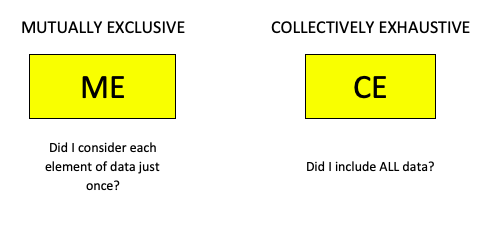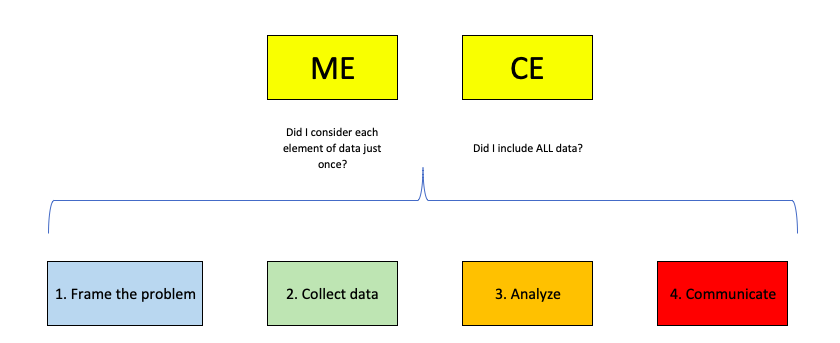
The MECE framework is a methodology, often used by management consultancy companies, that can be used for solving complex problems by breaking down and organizing data.
But why focus on problem-solving?
Simple.
Problem solving enables businesses to function to their potential
In today’s article, we’ll be looking in detail around the MECE problem-solving toolset and how you can get the best use.
What is the MECE framework

A business’s ability to identify issues and problems, remedying them in a systematic way, helps enable a business to be effective in achieving its goals.
In order to solve complex problems you need to have a method of organising the data and simplifying the problem solving process, the MECE framework, often thought of as a consultancy based tool, offers users a framework focusing on simplification and analysis.
We know that collecting and analyzing data is imperative in problem-solving. The MECE framework helps us ensure that this data is:
- Useful in solving the problem.
- Not misleading, which may result in a failure to correct the issue.
The MECE framework can help in enabling you to be better at decision making and problem-solving through these two core principles.
The MECE framework forces us to use data sets that do not confuse and include all relevant data so we don’t miss things that could be important.
The MECE framework is used extensively to target large problems. You’ll typically see it used by consultancy companies.
MECE is an acronym that stands for:
Mutually Exclusive– Items that can only fit into one category at a time
Collectively Exhaustive – Items that can fit into one of the categories.
In simple terms, this means small parts are not allowed to overlap (i.e., fit in multiple categories). The small pieces must add up to the whole.
Data is broken down into logical groups that can then be further assessed in order to resolve the business problem that is being faced.
It’s useful for targeting large complex problems by breaking them down into elements that you can appraise to help root cause analysis.
Let’s now look at each element in turn.
ME – Mutually Exclusive
Being Mutually Exclusive refers to how you break down a problem or data set into categories. The key rule is that they cannot overlap.
An example of something that overlaps could be a question such as:
- Break down a group of 100 people into what meals they eat:
You could structure this into
- Those that eat breakfast,
- Those that eat lunch
- Those that eat dinner.
This structure is not MECE; you will find individuals that overlap into two or three of the catagories. Therefore this is not mutually exclusive.
Another example would be
- Break down a group of 100 people into which continent they were born in Africa, Antarctica, Australia, Eurasia (Europe + Asia), North America, South America.
As they cannot have been born in more than one continent, the data cannot overlap and is MECE.
Other examples include:
- Customer age
- Defined financial brackets, i.e., revenue or costs
- Number of employees
- Country of Birth,
CE – Collectively Exhaustive
This term simply describes how the sum of the groups selected within the ME element must equal the whole of the group.
- Therefore if you look at earlier examples breaking down those that eat breakfast, lunch or dinner you may have individuals that sit in more than one category so your results will not equal your data set
- In our example, where we looked at which continent you were born in: the result will be the whole of the data set.
As you gathered from the above example, MECE is all about how we group and analyze information.
How to simplify the MECE framework
There are two further elements that you should utilize when using the MECE framework
1/ Data groups should be of the same size
For example, let’s say in framing a problem we’ve grouped our data set by location:
- London
- Manchester
- Paris
- Belgium
- Germany
They are exclusive (there is no overlap). It equals all of the data, so it’s exhaustive, but let’s look at those groups again.
We’ve grouped by the city – London, Manchester, Paris AND country Belgium Germany.
Our groups are not the same size – this could lead to misleading groups and hypothesis.
Secondly, let’s look at another example:
Segmenting Income value
As an example, you could segment your customers by earnings, so you could define your customer list according to the following:
- Under 15,000
- 15,001 – 30,000
- 30,001 – 45,000
- 45,001 – 60,000
- 60,001 – 75,000
- 75,001+
With these categories:
- All earnings range are covered
- No individual can appear twice (i.e., in more than one category)
- Groups are evenly spread (i.e., are spread roughly around 15,000 each.
However, there are six groups. To further simplify MECE you should look to minimize groups where possible so consider
- <30,000
- 30,001 – 60,000
- 60,001 +90,000
- 90,001 +
This simplifies our data set by reducing our groups down to 4 core groups whilst keeping the size of the values the same (i.e., bands of 30,000)
Where is the MECE framework used
The MECE framework is commonly seen operating in management consultancy organizations.
Candidates wishing to join such organizations are expected to be able to demonstrate the framework (it’s principles, structure, and issues) during an interview.
How to use MECE framework
For effective use of MECE – try to utilize these four basic principles.
- Frame your Problem/Question
- ME – Ensure that the data does not overlap
- CE – The sum of your groups MUST equal the whole
- Use similarly sized groups
- Do not use large quantities of groups, look to simplify (ideally 3 or 4).
The basic flow of the MECE Framework process is
- Frame the problem (i.e. We have to many production defects)
- Collect the data (Collect the production defects data)
- Analyze the data (Group the data, assess)
- Communicate the results
You can see the MECE process in the diagram below:

Benefits of MECE framework
As your no doubt aware data is integral in quantitative problem solving, however, using the wrong data can lead to you to think incorrectly and come to conclusions that don’t address your issue
Hopefully, you’ve seen from our description of the methodology some of the benefits of using MECE – it’s a great tool for reviewing problems – some of the key benefits include:
- Eliminating confusion
- Focusing only on key data
- Avoiding duplication
- Assists with visualizing problems
- It drives users to consider the details
- It helps you reach conclusions that can have an impact
Criticisms of MECE framework
As with any tool/methodology, there are some issues to consider, some of these include:
- Using poor grouping structures leading to wasted effort and poor quality results
- Inconsistencies in data, examine and test your assumptions with care
- Critics argue that the framework can be limiting as mutual exclusiveness is not always acceptable
Summary
I hope you enjoyed this introduction to the MECE framework. As you can see, it can help with putting a fresh perspective when problem-solving complex issues.
As ever we’d love to hear from you, do you use MECE framework in your job? Got some tips that you’d like to share? Fire us a message on twitter or use the comments section below.
Finally make sure you check out our great Problem Solving Guide that’s chock full of Problem Solving tools, techniques and methods.